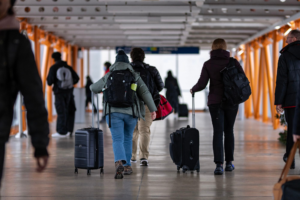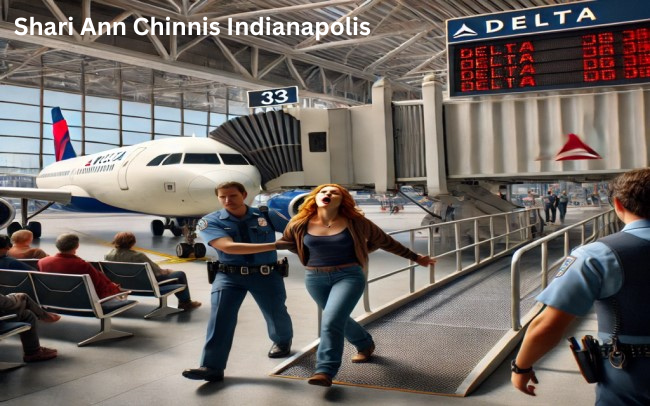Introduction
Taking a flight is a normal everyday occurrence and no one thinks twice when boarding a plane; flying is arguably one of the safest means of travelling. But as is often the case in aviation, with some airplanes at least, the normal run of the mill flight can provide the traveler with an experience that he or she will never forget. This was the case in a flight that I once took from Indianapolis to New York where a lady, who later turned out to be Shari Ann Chinnis, caused a scene. Reading through this piece of writing, a would be taken through details of the event with an explanation of what occurred, the law, and the things passengers and airline companies should know about such events.
The Incident Unfolds
A Routine Flight Takes a Dramatic Turn
The events of the flight from Indianapolis to New York, like any other flight, commenced as follows. People embarked with their possessions, secured them and got comfortable for a comfortable ride expected in the near future. However, misfortune struck before the plane could even take off the ground in the following manner. What was meant to be a normal flight soon took focus, not because of disturbance up the air and not because of air pockets, but rather because of disruptions on the ground.
The Disruptive Behavior of Shari Ann Chinnis
Before the plane could even leave the terminal, one of the passengers, Shari Ann Chinnis, seemed to become more and more unstable. By the observation of other passengers and at least one stewardess, she only grew more aggressive in her behaviour, and given that most of the passengers and staff are stranded in the plane, tension is normal. Further details of her conduct were not quite as obvious as to entice the flight crew into some compulsory action.
The Crew’s Swift Response
The crew which is prepared for such interventions acted in a very efficient and nonemotional manner. Yet for all the increasingly tense moments, they kept in mind the welfare of the passengers as well as the accompanies on board that such escalation was not to continue further. Due to safety concerns, more so for the occupants of the aircraft, the decision was made to taxi the plane back to the gate, for the policemen to act.
The Arrest and Legal Consequences
Law Enforcement Steps In
When we got near the gate, the police officers were all set to counter whatever had happened. Shari Ann Chinnis was apprehended thereby stopping the melee without any delay but the antecedents left their scars on the passengers and crew. And her arrest showed how seriously such actions are punished by the authorities, especially in such a controlled context as the aviation industry.
A Look at the Charges Against Chinnis
After her arrest Shari Ann Chinnis encountered a number of charges against her. Interference with a flight is not a petty offense; coming across as a criminal offense, it warrants fines of up to thirty thousand dollars and or imprisonment for a period not exceeding five years. The offences that she was to answer include creating disruption or nuisance but also potential harm or threat to the lives of everyone on-board the aircraft. Trespassing into an area which compromises the safety of a flight is unlawful and those that engage in it can be imprisoned for several years.
The Impact on Fellow Passengers

A Frightening Experience
As for the other passengers on the flight, the situation turned into quite something more than the discomfort of having to wait on the tarmac – it became frightening. The change of events forced people to open their eyes and some of them reacted to the situation on their social media accounts. Mainly, uncalled for incidents that cause so much fear and uncertainty can affect other passenger’s future travel despite the plane safely landing.
Social Media Reactions
It is unfortunate that in today’s world, information on similar events goes round the vane at the blink of an eye. Many people also used the social networks complaining but at the same time they were happy with the reaction of the flight crew. But some people tended to express their concern regarding the safety of airlines and the calls for better precautions to avoid such mishaps to happen in the first place.
Understanding Unruly Passenger Behavior
Common Triggers of Disruptive Behavior
Airplane misbehavior seems to be provoked by a range of factors such as nervousness, intoxication or psychological disorders. Under these circumstances, some of these factors get worse through the hard conditions of the carriage in restrained spaces such as aircrafts. It is up and important for the realization by air carriers and intending travelers for help in the management and avoidance of such occurrences.
The Role of Airline Policies
Carriage of passengers has some rules that airlines use to deal with rude passengers. These policies mean to ensure security of people on board and individuals who are in one way or another connected with the company. Starting from the point when a passenger demonstrates some signs of aggressiveness, the attendants are taught about how they should proceed to restore order and guarantee that the conflict does not escalate to the level where risk to the lives of the passengers and crew will be eminent.
Training for Flight Crews
Stewardesses are trained on how to manage aggressive people during a flight. This training involves procedures such as how to talk down an aggressive client, how to address such a client, and forceful techniques of dealing with clients if talking them down fails. The objective is to sort out the problem, and to do so with as little conflict and to keep all the passengers safe on board. A good example is demonstrated by the crew during the Shari Ann Chinnis occurrence where the training worked for their benefit.
Lessons for Passengers
Stay Calm and Follow Instructions
Passengers can learn quite a number of valuable hints, namely, one of the things they have to learn is how to remain nonemotional during such a situation. Stress and fear can make things even worse, and it becomes a risk-raising environment and confusion. Those inside the aircraft should always obey the flight crew at all times since they are familiar with tackling those situations.
Report Suspicious Behavior Early
Passengers are also advised to be on the lookout for any suspicious or any peculiar activity since they should report them to the flight crew. Some incidents, if addressed as soon as they occur, can be addressed and avoid making things worse, making the journey of all passengers and members safe.
Know Your Rights as a Passenger
There are passengers’ liberties, and among them, passengers have rights to have a secured flight. Acquaintance with these rights can enable a passenger to know what to expect in certain circumstances and how to name his or her action should the worst happen.
The Importance of Airline Safety Protocols
Ensuring Passenger Safety
It is always the aim of an airline to deliver passengers safely to their intended destinations and this is served by these safety measures. These policies include those before the flight, during the flight and in case of an incident they help to reduce the impact and contain the situation.
Continuous Improvement in Safety Measures
Industry players always monitor and make changes to their safety measures from time to time due to the occurrences in the field. Such commitment to safety assures that airlines will be in a position to overcome such oddities because safety of passengers is well taken-care-of. Such circumstances as the one shown in the case of Shari Ann Chinnis recalled the need for these protocols and constant attention.
The Role of Modern Technology in Enhancing Safety
What I believe needs to be stated unequivocally here is that technology has been a major boon in airline safety. While recent example of screening techniques at airport to alert systems during the flight, technology assists in the early detection and control of incidences. Airline companies are using these tools to achieve what they consider to be the maximum safety for passengers.
The Future of Air Travel Post-Incident
Increased Vigilance and Awareness
Catastrophes such as this one that befell Shari Ann Chinnis indicate that much more has to be done by the airlines and travelers in this regard. Socially, there is a heightened sense of safety as cases that may lead to accidents are quickly detected hence preventing them from happening; hence reducing the rate of airplane crashes.
Ongoing Training for Airline Staff
Alire training conducts for flight crews and ground staff is crucial to ensure that the safety levels are kept to the highest possible levels. There are a number of advantages as to why this training is useful, it makes the personnel of the airlines well equipped with the kind of skills and knowledge they require in order to handle any situation that may be arising.
Policy Updates and Enhancements
Airline may wish to change their policy or practices that led to the incidence such as this one to better enhance safety. Such updates may involve, for instance, more rigurous check-ups in the course of recruitment, better training programs for the members of the flight crew, and broader measures on how to handle obnoxious passengers. In this way, the managers of the airlines can always fine-tune the kind of process they are delivering, to make flying more safe and efficient for all parties.
Conclusion
This is because the safety of any airline depends on the effort of passengers and crew members as depict by the experience of Ms Shari Ann Chinnis on a flight from Indianapolis to New York. The greater society at large can come together to ensure that air travel is more tolerable and as safe as possible for persons to transit in the sky. By ensuring their safety standards are up to date and meeting these new emerging scenarios, the passengers should fine comfort knowing that safety is valued high by the airline industries.
No matter if you are a frequent traveller or you only fly once or twice a year it’s important to know how to act in such cases and it can definitely add a lot of value to the safety and comfort of the flight. In this manner, we can also make air travel safer and more pleasant for everyone – the operators, crew, passengers – for everyone and for those like the security personnel who are out in the front line daily protecting our aviation system.
